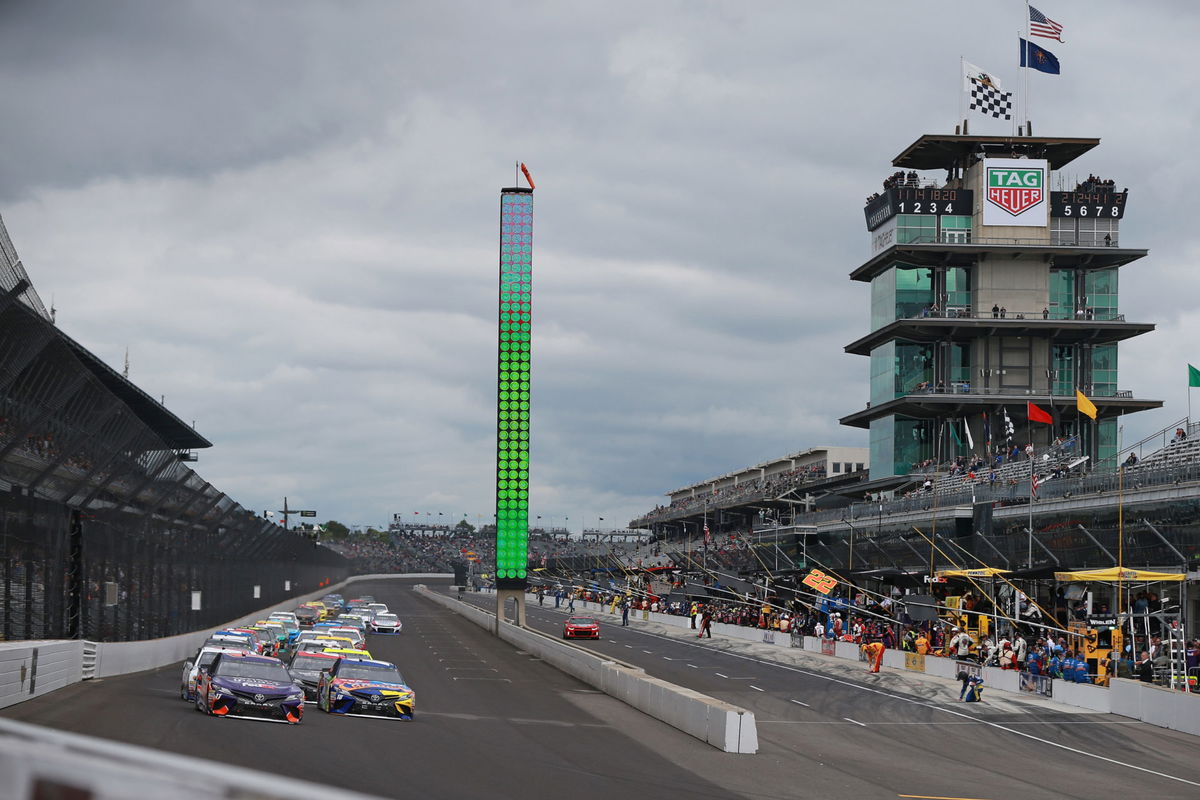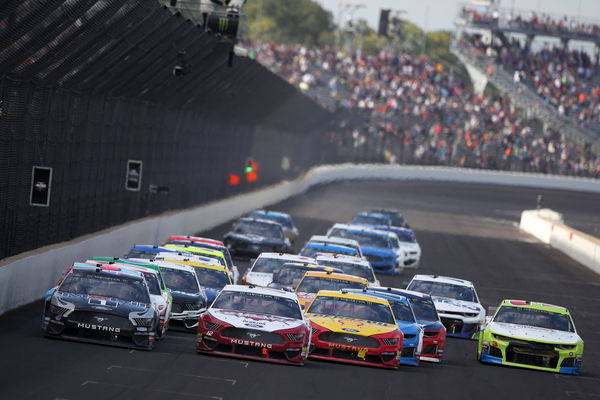
Getty
INDIANAPOLIS, IN – SEPTEMBER 10: Denny Hamlin, driver of the #11 FedEx Possibilities Toyota, and Kyle Busch, driver of the #18 M&M’s Caramel Toyota, lead a pack of cars during the Monster Energy NASCAR Cup Series Big Machine Vodka 400 at the Brickyard at Indianapolis Motor Speedway on September 10, 2018 in Indianapolis, Indiana. (Photo by Matt Sullivan/Getty Images)

Getty
INDIANAPOLIS, IN – SEPTEMBER 10: Denny Hamlin, driver of the #11 FedEx Possibilities Toyota, and Kyle Busch, driver of the #18 M&M’s Caramel Toyota, lead a pack of cars during the Monster Energy NASCAR Cup Series Big Machine Vodka 400 at the Brickyard at Indianapolis Motor Speedway on September 10, 2018 in Indianapolis, Indiana. (Photo by Matt Sullivan/Getty Images)
Earlier, news broke that the Brickyard 400 will be back in NASCAR. In essence, the stock car racing will be back on the Indianapolis Motor Speedway oval. It was first introduced in 1994 and ran all the way until the 2020 season before being replaced by the road course. Now, it has been three years and the fans already miss the oval layout and want it back on the calendar. However, one really has to wonder if this is a good idea to revive the race.
Watch What’s Trending Now!
Over the course of NASCAR history, there have been four races that are highlighted as the most important. They are none other than the Crown Jewel events, namely the Daytona 500, Coca-Cola 600, the Southern 500, and the Brickyard 400. Daytona was regarded as the biggest NASCAR race, the Charlotte race was the longest one, and the Darlington race was the oldest. Meanwhile, the Brickyard 400 was considered the richest. The Brickyard 400 actually replaced the Geico 500 at Talladega as a crown jewel race, but Talladega took it back after the former’s 3-year absence.
ADVERTISEMENT
Why did the iconic event leave the NASCAR Cup Series calendar?
As it turns out, the primary reason for its departure was the steady decline in racing quality. The seeds of disaster were sown all the way back in 2004 when the track was repaved for the first time in nine years. This had a significant impact on racing, and it was not just limited to NASCAR, either. Ask any older Formula One fan what the worst F1 race is, in history. Their answer would be the 2005 United States Grand Prix.
To put it politely, that race was a nightmare, and only six cars finished the race in front of hundreds of enraged fans. When the track was repaved in 2004, officials implemented a new procedure to make the track extra smooth. Unfortunately, there was a bit of a side-effect, where the tire wear would be significantly higher. F1 found that out the hard way, and that led to the 2005 farce. Later on, NASCAR would find out what the fuss was about, during the 2008 Brickyard 400.
ADVERTISEMENT
Top Stories
What Settlement Agreement Have Michael Jordan & NASCAR Reached? Everything to Know From Evergreen Charters to Payout

NASCAR Flexes Authority With Drastic ‘Sign or Sell’ Charter Clause Hours After $365M Lawsuit Settlement

Michael Jordan Makes 8-Word Statement After Forcing NASCAR to Lawsuit Settlement

Michael Jordan Brings NASCAR to Its Knees as Jim France’s Courtroom Collapse Triggers Settlement

Jordan Fish Pens Heartfelt Message for Fiancé Denny Hamlin After Dramatic Courtroom Settlement With NASCAR

What happened during the 2008 Brickyard 400?
This race was pretty much a massive disaster, and multiple factors contributed to this. First and foremost, the drivers were forced to contend with the infamous ‘Car of Tomorrow’. Throw in a newly paved race track and inadequate tires, this was a recipe for a shambolic race. This was because the race witnessed the slowest speeds and the most competition cautions in any NASCAR event. The repaving was scheduled after the 2004 Brickyard 400 and around 36,500 tons of asphalt was laid out in 2-3 layers.
ADVERTISEMENT
The speedway officials opted to use a process called Diamond Grind to smoothen the track surface. This procedure digs grooves into the racetrack, and they did achieve the desired effect. While it provided extra traction on the smooth track, it came at the expense of potentially causing more tire wear. The 2005 F1 US Grand Prix was a perfect example of this, and all Michelin-run teams suffered. It also rang the death knell for Formula One in the United States for a long time until the Circuit of The Americas.
As for the NASCAR cars, they did not have too bad an issue between 2005 and 2007. However, everything changed for the 2008 season with the Car of Tomorrow, and Goodyear not coming out with decent quality tires. So in the buildup to the NASCAR race, everyone was nervous. To their credit, NASCAR attempted to mitigate the issue with two mandatory competition cautions. However, they miscalculated the lifespan of the Goodyear tires, and Kurt Busch was the first victim.
ADVERTISEMENT
It only got worse from there for the NASCAR Cup cars
Soon, multiple cars were falling victim to tire issues and the problems just kept piling up. It got to a stage where a competition caution was needed every 10 laps, and even that was pushing the limits. The then NASCAR President Mike Helton even had to come to the commentary booth to publicly apologize for the farcical race. By the time the ordeal was over and Jimmie Johnson survived to win the race, 33% of it had been run under caution. Furthermore, the average speed was 115 miles an hour, and this was supposed to be the second biggest race of the year.

Getty
INDIANAPOLIS, INDIANA – SEPTEMBER 08: Kevin Harvick, driver of the #4 Mobil 1 Ford, leads during the Monster Energy NASCAR Cup Series Big Machine Vodka 400 at the Brickyard at Indianapolis Motor Speedway on September 08, 2019 in Indianapolis, Indiana. (Photo by Chris Graythen/Getty Images)
Since then, future races have not been as spectacular and popularity soon declined rapidly. Eventually, for the 2021 season, NASCAR switched to the road course layout and has been using it ever since. Unfortunately, it appears that even the road courses are not reviving much interest, and the racing quality is still declining.
ADVERTISEMENT
Will things change with the return of the Brickyard 400?
Recently, it was confirmed that the Cup Series will return to the oval layout in 2024. This news was met with much joy from the NASCAR fans. Even Kyle Busch and Kyle Larson confessed that they missed that race and several fans agreed with him. Many insisted that the racing was so much better on the oval layout and would definitely not miss the road course.
With that said, will the fans’ predictions and hopes come true? Busch has won twice in the past, and in 2024, he will be the only active driver to have multiple wins on the oval layout. Brad Keselowski is another driver who won on the oval layout, while AJ Allmendinger, Tyler Reddick, and Michael McDowell won on the road course.
ADVERTISEMENT
One concern is that nothing would change in terms of racing caliber. Of course, there shouldn’t be a repeat of 2008, as Goodyear would have learned their lesson by now. However, there is a little thought that while the 2024 Brickyard could draw in the numbers, the novelty will wear off. That all will depend on how the 2024 Cup Series race will play out, as well as subsequent races. Thinking positively, we can only hope that the Brickyard 400 delivers great races and earns back its status as a Crown Jewel race.
WATCH THIS STORY: “It Made the Racing Worse” – Dale Earnhardt Jr Blames the Indy Cars for the Absence of Indianapolis
ADVERTISEMENT
ADVERTISEMENT
ADVERTISEMENT

